Don't wanna be here? Send us removal request.
Text
The Rumors are True: Prisoner of Azkaban Made the Harry Potter Film Franchise What It is Today

Fantasy series adaptations don’t tend to get much praise on the quality of the films. The sole fact that they are adaptations and the fanbase behind the books will without a doubt comprise the initial viewings of the films must be a strong boost of confidence for the creators. Throughout my intense phases of reading and watching every single science-fiction and fantasy series I could come across, there came to be only a few that I now consider to be legitimately good films — within the restraints of the nine-film long Harry Potter period, Prisoner of Azkaban definitely makes the list.
The Harry Potter storyline still carries a special place in my heart, probably due to the overwhelming nostalgia I get from even the slightest reference as it had such vast importance in my childhood, but I can acknowledge how some of the films fall short. However, Prisoner of Azkaban shines like an actual diamond in the series’ filmography. Directed by Alfonso Cuarón in 2004, the Prisoner of Azkaban visualizes the shift in Harry’s, Ron’s and Hermione’s -as well as the overall series’- general atmosphere in a really sophisticated and impressive way. In the first two films, the main trio were actual kids, the unfolding events still required explanation to be concrete, the world building was still on-going. Starting with the third film though, backstories started to become less and less ambiguous; as Harry started to go further into his teenage years and become more conscious regarding the severity of certain things, the maturity of the films also increased and peaked with the third one.
youtube
Prisoner of Azkaban has possibly the best cinematography in the entire series. Countless one-takes with no cuts, mesmerizing color schemes that change course as the story becomes clearer, wide shots with chillingly beautiful sceneries… Directorial and technical visuality-wise, it is truly hard not to be in awe sometimes. Harry Potter and the Sorcerer’s Stone and Chamber of Secrets had more of an early 2000s teenage drama-esque picture to them, which is weird to expect in a fantasy series but still does not really catch the eye until an expectation-exceeding one comes along. The dominant colors in the frames that change from the beginning to the end, for instance, are not anything revolutionary but it is a first in the series itself. I think some choices, although they may seem subtle or irrelevant at an initial glance, contribute immensely to the overall seriousness and impact of the film.
It is not only successful with its technicality, though it is a huge portion of it. The story is much more neatly constructed here too. The plot-twists are inevitable in a Harry Potter film / book, there’s one in every part of the series, but in my objective approach I wasn’t as surprised in the first two as I was when watching Sirius completely change character in Harry, Ron and Hermione’s eyes. I link this to firmly believing something only to be wronged — a contrast to the first two where the audience, as well as Harry, did not know enough to completely believe in something, it was always a speculation or a mystery.

Another perk is: it has time travel — a concept I can’t believe we only see once in the series. The details given to suggest the idea of someone time traveling are not really overt but once it is revealed, they just fall perfectly into place. These parts are just such an entertainment to watch, watch, watch and watch. I cannot ever get sick of it. Hermione’s intelligent and quick-planning mind is also a strong highlight (girl power!). The way Dumbledore trusts a third-year student with something as fragile as time travel so she can get access into all her studies is pretty extravagant not only on Dumbledore’s part, but also Hermione’s. Risking irretrievable damage to be able to study to the farthest extent? A true study-motivated legend who, may I add, punched Draco in the face within the same film — the peak of cinema is right here.

One more thing about this film is that I remember being so glad that finally we get to have a glimpse of what Harry’s parents’ normal life might have been like. The addition of characters (Remus, Sirius and Peter) both adds into the more sentimental aspects of the story, while also increasing the expectations and excitement for the rest. Watching Harry get the chance to bond with someone who has the most parental-figure potential in him was just incredibly heartwarming.
Prisoner of Azkaban has the most amount of enchanting magic in it. So many pretty, comforting, emotional and stunning shots that it’s difficult to focus on only one. It never ceases to be amusing, looking in retrospect and trying to make sense of even the smallest details, only to be mesmerized by its magic all over again.
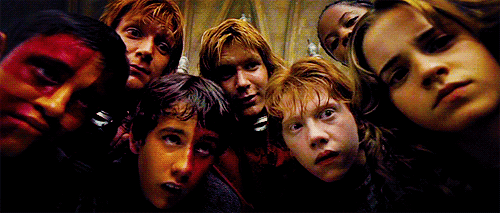
#harry potter#prisoner of azkaban#books#cinema#film#hp#potterhead#hogwarts#hermione#ronmione#sirius#lupin#Youtube
5 notes
·
View notes
Text
花樣年華: Never Mind

Something about the ambiguity of youth draws attention like nothing else. Coming-of-age books and films, it almost feels like they will never get old. I, despite not being the biggest fan of either medium genres, wholeheartedly understand why and how they gather so much love and praise. The growing up pains are truly unlike anything else that one can encounter; such a twisted, patchy journey in which the end game is somehow terrifying, tempting and bittersweet all at once. The concept itself is one I can find myself seeking comfort in when I desperately crave distraction, a light getaway from the mundane reality of everyday life. But the escape route found within these sorts of films and books is much different to the ones found in fantasy or sci-fi genres. It’s more wholesome, more soothing and calming. When this subject is combined with music, an actual physical figure of nostalgia is formed. BTS’ HYYH albums (Part 1, Part 2 and Young Forever) are the pure embodiments of youth and every little companion that follows in its footsteps.
The inevitable cliches that come with portraying teenager / young adult lives are what I feel like are quite hard to detect when it comes to music. This is in certain ways both a perk and a con, in my opinion. It’s a con because these cliches in films and books serve as saving points — ones creators can turn to when in dire need, knowing perfectly well they will do the deed. I honestly cannot think of a cliche script to be used in a song centering around youth (even bland lyrics don’t seem to have the same impact a cliche plot or line has on me). On the other hand, it feels like a perk because it’s the ultimate chance for the listener to experience something new with each artist’s song. No growing up story is the same, yet a considerable majority carry similar elements, similar low points and similar emotional enlightenments. Taking youth as the basis of an album gives the artist so much material to choose from. An endless supply of teenager angst, heartbreak, hope, dreams and affection.
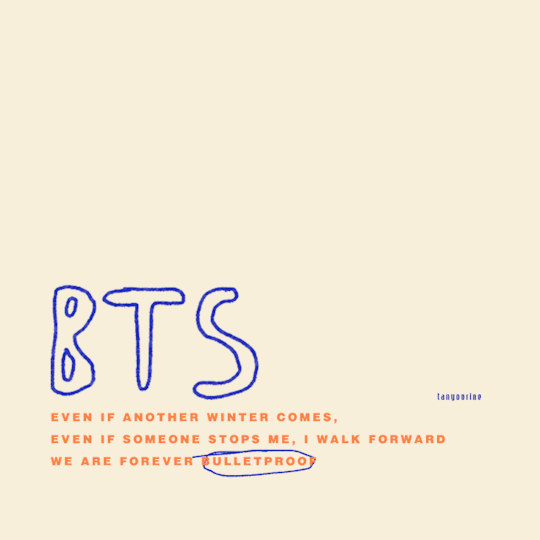
Every time I listen to BTS’ HYYH albums (translated to The Most Beautiful Moment in Life) I feel the traces of memories I never had and relationships I never actually witnessed. The details are imaginary, they belong to the minds of others, but the essence of them all is the same rough journey that is reaching adulthood.
One particular song I believe will never cease to have the utmost emotional effect on me is the intro song of The Most Beautiful Moment in Life Pt.2: Never Mind. Talking about not only mental health that practically becomes fragile in the prime of teen years, but also the process of finding a dream to clutch onto, to put all your belief and hopes in; these carry so much depth and meaning that it’s hard for me to try and put their worth into words. Intro: Never Mind is the kind of work that it’s obvious it derives from a place of real life, it has that undeniably raw sense of being lived through. The reality, however, does not degrade its ability to incorporate the lyrics into your own life, any life.
The perfect introduction to the part 2 of what I consider to be the best era of BTS. Every lyric scribbled in this three part series is the most special combination of depressing, heart-wrenching, vehement, comforting and hopeful words I have personally ever come across. These are the types of albums you can just never seem to let go or grow out of. They hold too much nostalgia.
youtube
I used to run only looking the front
Without sparing a moment to look around
Before I knew about it, I had become the pride of my family
And I had become fairly successful
The time called adolescence
I suddenly think of it
Back then I was young and had nothing to be afraid of
A few frustrations meant nothing
The only differences are my height that increased a bit compared to then
And my view that matured a bit more compared to those of my age
From a basement studio in Namsandong
To Apgujeong I laid my beat, the origin of my youth
Everyone around me told me not to go overboard
They told me I’d make my whole family go broke if I acted like some musician
It was then that I stopped caring about whoever said whatever
I just lived my life the way I wanted, the way I believed
How do you think I am now?
내가 보기엔 어떨 것 같아? How do you think I think I am?
내가 망하길 기도했던 몇몇 놈에게 물을게 I’m asking this to those who prayed for my failure
Do you think I ruined my family, you bastards?
I don’t give a shit I don’t give a f*ck
Like I said hundreds of times every day
‘Take your damn attention off me’
We can taste failure and hang our head in frustration
We are still young, so don’t worry about anything at all
On a stone that doesn’t roll
Moss grows certainly “A rolling stone gathers no moss” in Korea usually means one who diligently endeavors neither settles for the present nor falls behind. “On a stone that doesn’t roll, moss grows certainly” therefore means one who doesn’t consistently try hard will surely lag behind
If there’s no way back, go straight
Forget about all your mistakes
Never mind
It won’t be easy, but have this engraved in your heart
If you think you’re gonna crash, accelerate even harder, you idiot
Never mind, never mind
No matter how thorny the road is, run
Never mind, never mind
There’re a lot of things in the world that you can’t control
You better
Never mind, Never mind
Translation Link

8 notes
·
View notes
Text
Boo Netflix with an N

One thing that I crave in my life is romanticization. Romanticizing little details, using imagination to discover hypothetical and fantastical worlds, no matter the believability and the circumstances. It’s an easy concept to put into words but quite hard to execute on a daily basis. This specific reason was why I loved and cherished Anne with an E as much as I did; it had the romanticization I could only dream of.
Anne with an E is a TV series adapted to screen from Lucy Maud Montgomery's 1908 classic Anne of Green Gables in 2018. It centers around an orphan little girl being given to an elderly brother and sister as an adoptive child in 1896, yet the siblings were in expectation of a boy to come to help around in the farm. When the “boy” turns out to be 13 year old Anne due to a mix-up, Matthew and Marilla Cuthbert hesitate, refuse and deny only to fall in love with Anne’s presence in no time. The lively voice she adds into their home is irreplaceable and not like anything they have witnessed in their long lives. Soon enough, Anne even gets the chance to change her name from Anne Shirley to Anne Shirley Cuthbert — making her a prominent member of the family.

Throughout several seasons, we watch Anne start a new school and go through various attempts at making friends and fitting in with the general Green Gables crowd. However, her sunny and unique personality is not always well received. She has to put up with further bullying, much similar to the ones she became a victim of in her orphanage years. The way she pays extensive attention to the tellings of stories, uses her endless imagination to add life and color to everything and everyone she deems lacking, stands up for herself even in the most dire and threatening situations because she cannot put up with injustice; these are all qualities that the people of Green Gables do not associate with women, let alone 13 year old girls who were initially outsiders. Her entire character is like a shockwave running through this small village, touching upon every resident who’s upper class, lower class or casually in the middle. Her peers, of course, are much brutal with their expressions, constantly humiliating and hurting Anne at any possible chance until they, too, fall for the sunshine she willingly spreads around.

The personality traits given to Anne are ones I am most definitely envious of. The episodes showcase multiple severe scenarios that tie back to societal issues still seen today, and Anne’s demeanor and attitude towards each is admirable to say the least. Since she is a kid, it does not surprise me at all of how emotional and perhaps overly dramatic she can get at certain parts, but that really is the cause of nature. The maturity woven into her brain and heart is so powerful, so blinding that the rest just fades away automatically.
The town of Green Gables is purely livened with Anne’s arrival, making people become more aware and conscious of censorship, women’s rights, proper education, objective criticism and, most importantly, literature and imagination. Watching Anne roam through the woods, making up fairytales with a couple of her friends as they pass along is just a comfort scene from beginning to end. Refreshing shows like these deserve more love and appreciation than most of the overrated series circulating the entirety of social media do, but end up being cancelled nonetheless. Anne with an E only has three seasons due to Netflix deciding not to continue it further. Out of the countless lousy choices Netflix has made ever since it gained this wide of a range of customers, I have to say, limiting the story of Anne in the screen has to make the top 5. Still though, even if the original intended ending is one left for our own imagination, these three seasons carry with them enough life and dreamy atmosphere to last for a long time after the first viewing. A purely heartwarming tale.

13 notes
·
View notes
Text
Petition For Stars Hollow To Be A Real Town

There are only several shows I find myself returning to whenever I need the comfort of something familiar; Gilmore Girls is without a doubt one of the top ones of the list. Ever since I have first watched it two years ago -which is a late hop-on to the series, I know- I have come to the point of memorizing every little quote without intending to. Even with me knowing what’s to happen every minute of every episode, I still consult to its welcoming story.
Gilmore Girls is a drama-comedy TV series that aired between 2000-2007; there is also a limited episode sequel titled A Year In The Life (2016) but I like to think it does not exist. The story takes place mostly in Stars Hollow, a little town in Connecticut that’s as fictional as things can get. Lorelai Gilmore is 32 year old single mother who got pregnant to her daughter Rory in the early age of 16, now living in Stars Hollow, working as the manager of a local inn. The pilot episode starts with Lorelai going to her not-so-very-friendly-but-incredibly-wealthy-and-elite parents to ask for money so she can put Rory into a private highschool so she can have a higher chance of getting into her dream university, Harvard. Emily and Richard Gilmore, the parents, are happy to pay the tuition money for Chilton Prep School, but also take this opportunity to try and rekindle their broken and distanced relationship with their daughter, and see more of their granddaughter they hardly even know. From the start of Rory’s days at Chilton, Lorelai and Rory start having weekly Friday night dinners at the Gilmore’s house, for the next seven years.

Gilmore Girls is the type of story that flows on its own. One second, you’re on episode two and then suddenly, it’s episode ten. It’s the sort of series you don’t need to overthink or need time to digest. It’s the perfect friend to distract, comfort, entertain and relax you with incredible ease. There are an amply of aspects I deeply appreciate and value about Gilmore Girls but I’ll only mention a few, so this post is not a 10 page essay of me blindly fangirling.
First and foremost, Lorelai Gilmore is probably one of the best, cutest, sweetest and most admirable characters I have seen in a TV series. Despite being raised in a literal mansion with filthy rich parents, Lorelai is anything but spoiled or shallow. Granted, we see her in her 30s as a business woman, but even with every flashback or mention of her past self, it becomes fairly obvious how her demeanor has not changed that much. She’s so free-spirited, independent and full of youth that it saddens me how I’ll never get a chance to actually meet her in real life. Getting pregnant at age 16, only to leaving you parents’ home after giving birth so you can escape the suffocating pressure’s of their standards that are shaped in accordance to the society’s perceptions, could not have been the slightest bit easy. It’s a twisted and rocky situation, kind of explains her butchered relationship with her parents, but watching how she deals with every hardship is actually so inspiring. You can effortlessly see how she can manage balance between adopting maturity and a strict discipline towards not only her own life but also Rory’s, and having the sunny and optimistic attitude that makes being around her so entertaining and irresistible. Her jokes, sarcastic remarks, openness and colorful aura are everything I aspire to be if one day I become a mother.

Just like Lorelai, the show itself also carries within it a realness I truly love. Most of shows like these, from what I have seen, can convert to being a cliche and predictable mess within only a few episodes. They can also try too hard to squeeze drama out of every tiny instance, making it scream “forced”. Gilmore Girls does a really good job by not letting it get to that point of cringey overdramatized scenarios, but also not becoming too real to the point where it starts dying down out of boredom. It’s perfect mixture of comedy, wit, angst (at times), romance and family drama to get someone like me utterly hooked and in love. The dialogues are always full of smart and substantial remarks that I sometimes take not of the phrases they use — phrases that carry comedic relief and puns so subtly that you don’t get annoyed because it becomes obvious they are trying to be funny, but also just overt enough that you don’t gloss over the joke. The most lovable balance I seek in a comedy drama.

The last, but definitely not least, feature I love dearly of Gilmore Girls is the aesthetic it has. I don’t know if this is strange to focus on, but Gilmore Girls portrays the light academic aesthetic to the dot. The episodes set in winter and autumn are always the best ones to watch and get immersed in the pretty ambiance. Rory’s freakish love of books and studying, the architecture and interiors of Chilton, Yale, Harvard, the Gilmore house, Stars Hollow… They are so aesthetically pleasing that I recall times where I got my study motivation from the mere visuals of the show.
Every character in Gilmore Girls, I can point out timeframes for when I absolutely adored them and for when I felt like I could petition for them leaving the show at that very instant. I can think of numerous times I have cried or at least got teary-eyed despite having watched these scenes over and over again. I love the warm hugs this shows gives me, I love how its friendly and intimate atmosphere is so comforting to me and eases my mind when I feel overwhelmed or distressed. I love returning to the welcoming streets of Stars Hollow, jotting down book and film names I catch between the dialogues, discovering new songs and bands, and getting lost between the romantic relationships as well as lovely Friday night family dinners.

9 notes
·
View notes
Text
It’s The Little Things, The Luxuries

Microhabitat is a 2017 drama / romance by Jeon Go-woon. The director has very few films attributed with her name but as seen with Microhabitat, it’s more of a “quality vs quantity” type of situation. Apparently, quality also dragged in the epitome of comfort.
The film revolves around Miso, a 30-something year old trying to find a place to live and revisiting the friends that companied her college years during the process. Miso works as a maid in only a few small apartments, justifying how she’s barely able to get by. It’s quite the painful sight, just watching a person roam the streets of Seoul, in desperate need of help... but Miso’s personality makes it all worthwhile. I have trouble imagining how I would be acting in such a situation — so rough, so damaging. Would it require me to swallow my pride, do what I thought I would not do, call people I would rather forget? I guess these lead to more of the hard-to-predict answers, solely based on assumptions. You can never be 100% certain unless you live through it, right? Well then, Miso can be the strong and free-spirited role-model I will keep in the corner of my mind, showing me how there’s never one way to live your life, never one correct solution to a problem.
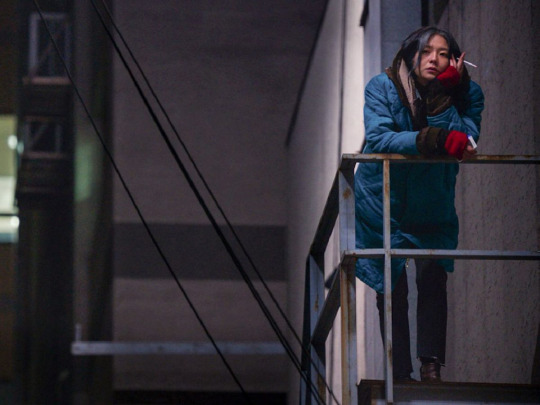
The usual advice, the over-used motto, generally follows the lines of accurate prioritization: necessities first, luxuries second. It works, too. It’s a straightforward and precise strategy to get your responsibilities over with. However, if this responsibility is time consuming, even draining at times, if it is one that’s far-stretching, never-ending, suffocating, stressing… it’s never going to be “over with” — or at least, not in the near future. It is times like these that require a shift in priorities, a subtle sorting-out of our initial concerns to remind us where the delicacies of life are truly hidden in.
Throughout Microhabitat, there is only one consistency: Miso’s love for cigarettes and whisky. It does not really serve a purpose if the cost of cigarettes is more than she can afford; Miso manages a way. It does not really matter where she is, Miso finds a bar to enjoy her whisky at the end of a tiring day. With the money she ever-so-often gathers, these two make up the top of the list, nearly always. It’s a controversial rationale, I must admit, but it’s what she has. It’s what she holds onto to feel the slightest glimmer of relaxation, the emotional support luxury.

Films like Microhabitat have real special places in my heart and I feel forever grateful that I got to witness the lives of these subtle characters. Pretty and slow, calm yet serious, heavy but still oh-so-light dramas with strong and willful, confident women taking the leads… What more can I possibly ask? It’s never the sharpness of the hardship that one is impressed by, it’s how it’s dealt with, how it’s survived. It’s been a while since I’ve seen Microhabitat, but I still feel both like a proud mom and an inspired little sister when I remember it.
19 notes
·
View notes
Text
Poetry of Agnes’ Song

Lee Chang-dong’s 2010 feature film Poetry is know to be one of the gemstones surfaced in the cinematic world of South Korea, rightfully so. The wondrous film starts off with quite the contrasting, bleak first scene: a body, floating in a relatively small town’s river. The body is then declared to be that of a high-school teenager — a girl who took her own life by jumping into that river.
What follows is the daily life of a 60-something year old Yang Mija, a meek grandmother trying to raise her grandson, Wook by working as a caretaker for a disabled older man. She is first seen in a hospital, complaining about experiencing certain aches and struggling with memory loss for specific words. It is only gradually that she is told she has Alzheimers, and the memory loss will only get worse from here. It really is a heartbreaking thing to witness, not even remembering the word “wallet” at the cash register, but what feels like a punch in the gut is actually her grandson’s, Wook, horrendous crime.
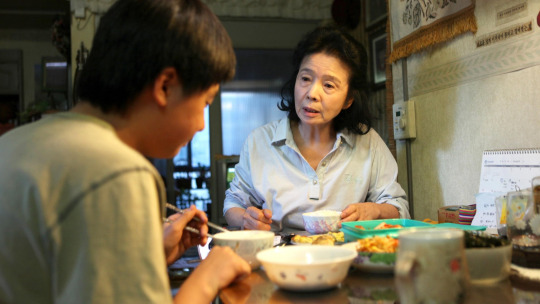
Mija is invited to a gathering by one of Wook’s friends’ parents, thinking it is fairly casual, but discovers to be petrifying. The body floating in the river was named Agnes Hee-jin — a teenage girl who committed suicide after being the victim of gang rape for several months by her 6 peers, including Wook himself. The devastation is real, heavy and shocking. The boys’ parents arrange a meeting to settle the amount of money they will give to Hee-jin’s farmer parents, hoping not to file a lawsuit. The amount is not what Mija can conveniently pile together, but not impossible.

The burden suddenly latched onto her back is vividly clear, from her gentle expressions to her attitude towards Wook. In the midst of disappointment and grief, Mija seeks shelter in poetry. She joins a poetry writing class right after learning about her Alzheimers, with all the excitement and devotion she has. The instructor wants one poem from every student by the end of the one month period. It’s not an easy or smooth process, but Mija’s enthusiasm conquers nevertheless.
Poetry is the epitome of gentle. The 139 minutes fly by, each more saddening than the previous. Watching an elderly woman cling on to writing -no matter what she opposes, what she fights against, what desperation she is drawn into- is purely promising. Art having this healing power is frequently glossed over — sometimes criticized, even. I guess one must not have felt the comfort of having an eloquent method of self-expression to think such a shallow thought. Literature is a shield from the cruelty of the outside. Whether you are the reader or the writer, it masks the haunting reality by diverting your attention to the slow and subtle details, visions, and feelings.
This is basically the battle of a woman. Her battle against dealing with bone-chilling crimes and giving up to old age, memory loss. It is the graceful story of her consistent courage, inspiring sophistication. It is as beautiful as it is somber. Mija fights her illness with art, capturing the complexity of her emotions in the poem she delicately assembled together, dedicated to Agnes Hee-jin.

0 notes
Text
Modern Folktales

As far as English songwriting goes, I guess it would be fair to say Taylor Swift’s name is one carved on thrones. Throughout her many albums, starting from when she was an inexperienced 17 year old to when she is a 32 year old with a trail of musical history following her, it’s possible to witness the gradual growth in the lyrics she writes. The most prominent examples that do her talent and capabilities’ justice are the two “sister albums” she released during 2020’s dreadful quarantine period: folklore and evermore.
For someone who had switched her ultimate genre of music from country to pop (sometimes rock) several years ago, the indie style of the latest two albums came by as a surprise to many, though I have always seen it as a shift that’s bound to happen one way or the other. It was only a matter of time before Taylor initiated an album where her lyrics were the focal point, and the light ethereal melodies were more of a compliment. Not only did she find a place in this new genre, but she also cultivated immense success and praise with it — as she should.
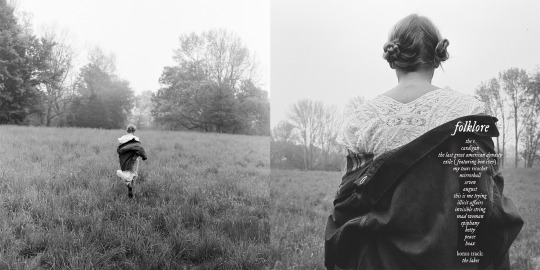

The first release was folklore, in July 2020. The photos that were released during the one-day countdown for the album were only glimpses of the atmosphere for the lyrical novel that was to come. Black and white sequences of imagery matched with the light, dreamy-like state of the songs perfectly. There is a beautiful coherency that’s diligently woven, and this musical similarity is undeniably an important factor in the overall impact of the album. It almost feels like you reach the end of a poem, of a novel every time you experience folklore from start to finish. Another remarkable aspect is the very thin line between imagination and reality in its songwriting. The fictional stories she has openly stated to have figments of her creative vision, are also interpreted as carrying fragments of her own past. How the two worlds mix together to form seamlessly flowing tales is incredible.
In folklore, Taylor tells the stories of a mad woman seeking revenge from the ones who painted her as the villain; a high-school sweethearts’ entangled love triangle with the cardigan-august-betty trio; how the last great american dynasty, referring to the former socialite resident of her home, Rebekah Harkness, had clawed her way through a media-centered life quite similarly to Taylor herself; her grandfather’s war memories of 1942 with epiphany, describing them to even be reminiscent of today’s pandemic period; the timelines of illicit affairs with the way they shine until their evident moment of decay; and heartbreaking partings through songs like exile and hoax. The album has multiple layers to pick apart and analyze, and you can discover a new detail every time you listen. There really is no fair description of how captivating it all is
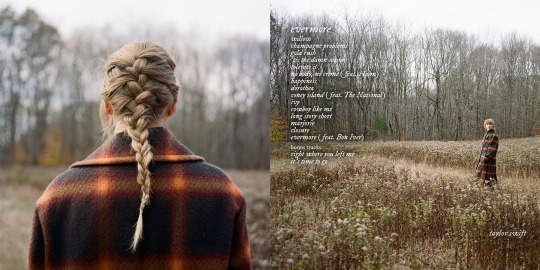

edit credit: jaoweasley on twitter
A few months after, in December 2020, Taylor again announced the “sister album of folklore, evermore”, only a day prior its release. Following the similar path of using the songs to tell folktales, evermore was crafted under a more fall-winter atmosphere, truly being the continuation of her sister. Taylor’s poetic escapism once again created imaginary storylines that still clung onto that one branch of reality. Whether they be rooted in her own, her loved ones’ or our own pasts, every bit of lyric can spark something in anyone and everyone. Some of the songs carry bits and pieces from what folklore had to tell, though it does add new stories, new perspectives and new characters into the mix. This time around, we listen to the tales of a murder mystery fiction where Taylor vengefully kills her friend’s domestic abuser husband in no body, no crime; a harrowing rejection of a marriage proposal in front of an uncomfortable crowd, with every grim detail of champagne problems; a relationship where celebration is absent and you only tolerate it, inspired by Daphne du Maurier’s 1938 gothic novel Rebecca; another anthology, including songs like dorothea and ’tis the damn season where a figure of stardom is seeking a shelter of freedom and secrecy for the weekend; the falling in love of two con artists with cowboy like me; and a heartfelt tribute to Taylor’s grandmother Marjorie Finlay, appropriately titled as marjorie. The bond between each song, both the above-mentioned and the unfairly left-out, is stronger than ever. Very much like folklore, it’s hard to realize just how evermore starts, pulls you in its world, and ends. Even songs that are purely autobiographical, like long story short, fit into the coherent universe admirably. Once you lose yourself between each lyric and melody with Taylor’s soothing vocals, it all feels like a faint dream.
youtube
youtube
her singles cardigan from folklore and willow from evermore
Taylor Swift’s songwriting has always been a topic of praise. She had always embedded stories into the core of her songs. What I think made folklore and evermore standout even more than her past works was just how maturely structured each track was. The lyrics stood out more than ever, thanks to the mellow instrumentals, made her soft voice absolutely shine. It is possible to detect the countless emotions derived from these stories by her voice alone. Such delicate audio automatically makes you focus on the words that are being uttered, the words that paint possibly some of the most beautiful stories ever. Taylor’s meticulous attention to detail had been a strong quality of hers, undoubtedly helping the longevity of her discography. There’s a certain level of rawness in how she chooses her words. This was one of the few reasons why even the most personal songs with direct names and places thrown in there had the ability to emotionally affect the listeners, outsider listeners to her vulnerable stories. Her metaphors are too real, her location descriptions are too tempting, her feelings are too accurate. Her imagination, combined with every other laudable talent of hers, casts an enchantment on folklore and evermore.
It’s physically hard for me to imagine a time period where these songs will lose appeal, become boring or fade with old age. Every time I find comfort in these ethereal tracks, I can only think of them aging like the finest wine out there, one that is much too extravagant for my taste. There is no set limit on how magical this sister duo can get or how often they reveal new fragments of Taylor’s genius artistry. One thing that is wholeheartedly assured though, is new experiences every single time you hit the play button.
1 note
·
View note
Text
Living Pictures in the Mind of a Serial Killer
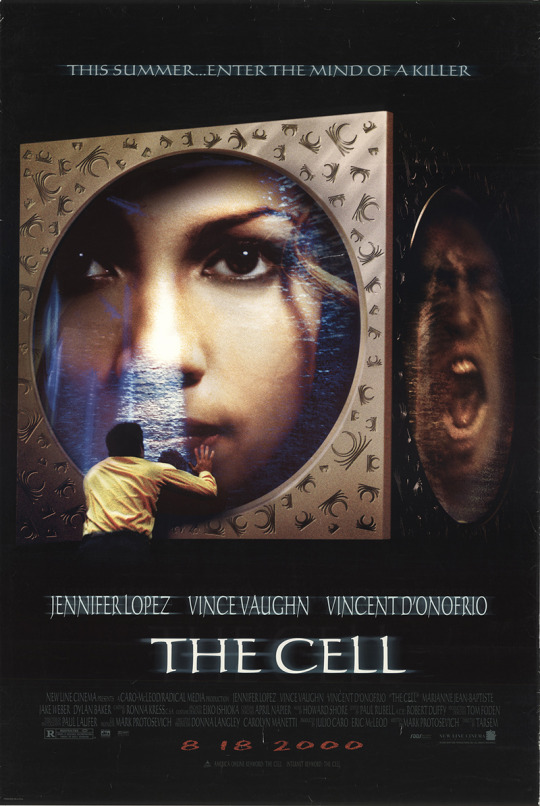
Tableaux vivant, French phrase for “living pictures”, are performances that have little to no movement within their components. The static and posed scene that lingers longer than an it usually would, is really a replication of a painting. They are brought to life, generally under some dependent context, with costumes and set designs in accordance to the work they’re influenced from. Such concept works best when presented through a screen, in my opinion, and gives the viewer a chance to absorb what is being presented through a bigger picture. Tableaux vivant’s rootedness in cinema may seem subtle and overlooked if one does not have the closest relationships with painting culture but, nevertheless, their vivid appeal to aesthetic pleasure is almost impossible to go by unacknowledged.
Out of countless films that use tableaux vivant as either a mere supplement for their narrative or as an essential script, it’s not unlikely to hear some titles twice. Tarsem Singh’s 2000 science-fiction horror The Cell is one of those repeated names, predictably. The amount of references to paintings that were squeezed into this 107 minute eerie rollercoaster is appreciation-worthy even by itself — because, really, there is a lot. With the gratifying pleasure of choosing which recreation of paintings I would like to scratch the surface of, I landed my decision on one of the most beautifully disturbing ones I came across.

Odd Nerdrum’s Dawn, 1989
To label the tableaux vivant in The Cell as only serving the plot or only serving the aesthetics would be unfair to whichever end that remains unchosen. Essentially, The Cell depicts the story of a child psychologist, Catherine Deane, using a device to enter the virtual mind of unconscious patients and trying to persuade them into breaking out of coma. As Catherine works with specialists who are both medically trained and know how to operate such complex system, when an arrested serial killer lays unconscious, the police need Catherine’s help in waking Carl Rudolph Stargher, the killer, out of his comatose state so he can be questioned on where the teenage girl he trapped in a cell is. Running out of time, Catherine steps into the grim and horrid mind of Carl — where tableaux vivant are used in all their peculiarity and glory.
In the film, Catherine is not the only character with the somewhat misfortunate chance to enter Carl’s subconscious; the investigative agent on this case, Peter Novak, also takes a dive. The entrance is like a fall. A fall through twisted and physically bent layers of a killer’s mind. When Peter makes his rough landing, he finds himself in the midst of a creepy, vexing scenery.

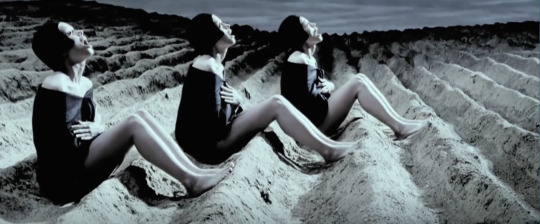
The camera slowly tilts towards the ground, showing us what Peter fell from, to what he fell into. Three women with bizarre pieces of cloth tightly wrapped around their upper bodies sit diagonally, looking up at the sky with their mouths open. The inspiration from this particular tableau vivant was from the Norwegian figurative painter, Odd Nerdrum’s 1989 painting, Dawn. The resemblance here is pretty uncanny, not some concealed reference you’d easily miss. Uncanny to the extent that I got shivers down my spine. It is just not a sight you have the fortune of seeing everyday, thankfully.
The choice of Dawn in representing Peter’s initial experience of Carl’s mind makes quite the bit of sense to me. In the original painting of Odd Nerdrum, the individuals lined on the ground give the illusion of screaming into the void. Since the painting has no chance of including sound, that is literally what it is. Their hands are invisible when bound tight with the piece of clothing wrapped around them. Though, it is possible to trace the outline of their hands and one could assume they have their palms pressed together, ready to pray. They look desperate, pleading. Whoever they hope to reach out, is apparently unbothered. Left in a barren and really, really depressing middle-of-nowhere, the overall suffocating atmosphere of their isolated suffering is haunting. How Carl’s mind’s entrance seeks meaning in this tableau vivant is interesting enough to dig deep. Carl Rudolph Stargher, the vicious serial killer, gains a portion of his merciless demeanor from the traumatic past he had to endure as a child. Although past trauma is no indication of current behavior, it is not unlikely that a person this cruel, also came face to face with cruelty — that cruelty being his abusive father. Having no source of consolation when you’re a literal child enduring verbal, mental and physical abuse is heavy to even imagine. The silent cries of the three women in the film could surely fall in line with how Carl’s pleas for rescue were left alone in a dark and desolate field. He could be the fourth individual that is present in the painting, but not there in the movie. Additionally, it is stated a few times of how police actually believe he wants to be caught. He is depicted as this unstable individual who shifts from knowing very well the torture he puts these girls through is anything but okay, to a conceited, selfish, evil person that gets pleasure from the pain he inflicts. Desperate screams do not have to only signify his childhood, his current state is just as twisted. What the piece of cloth represents could be construed as both his heinous father and his equally horrid self; same thing, different texture of clothing. I believe Dawn to be a perfect introduction to a mind as perverse and triggering as Carl’s because it serves as a common grounds for his past and his present at the same time.


The painting and the film still do have differences between the two, I mean, it must be near impossible to duplicate paintings to the dot, plus, where’s the originality in that? The more stylized version in the movie is much cooler in tones. The only ounce of warmth I can feel comes from Agent Peter’s shirt and even that seems drained of life within seconds of being there. The curvy hills that paint the sky in the original painting are not as emphasized in the movie, sort of strengthening just how alienated these three are from the outside. The barrenness becomes all too clear, once again. The afternoon-style cloudy sky of Dawn, is a much heavier accumulation of depressive thoughts floating on top of your head in The Cell. Costumes, being probably an easier element to duplicate, are identical except for the exposure of their bottoms — which, I understand. The ground is yet another difference from the painting; the narrow isles of it are much deeper and clearly distinguish the position of each women, possibly marking how though they are alone in this apparently endless desolate land, they are not even a unity.
Using tableaux vivant definitely adds extra substance and meaning to what is being presented on screen. If I were to sit down and try and analyze every painting referenced in this movie, it would leave me feeling lifeless but satisfied to witness the meticulous and consistent attention to artistic detail. Cinema is a medium where the possibilities and number of ways of expression are endless; these prove it.
30 notes
·
View notes
Text
First Died in January 2020
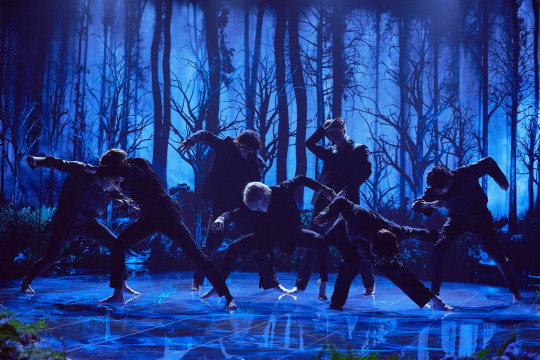
“A dancer dies twice — once when they stop dancing, and this first death is the more painful.” - Martha Graham
Experiencing, overcoming, living.
I think it’s hard to imagine how to constantly accomplish these tasks until the day you die without having a branch to hold onto. Usually, that branch is a dream. A goal, set to be the light at the end of an obscure, dark tunnel. A passion to physically urge you to move, work, not lie defeated. And when you dedicate your past and present to something, anything, it’s even harder to imagine how your life can survive without its presence. That first death, when the core basis you piled every little thing on top of comes crumbling down on you, is the epitome of agony. Black Swan by BTS is the ultimate portrayal of this suffering. Through its lyrics, visuals and genius choreography, the death of passion becomes depressingly visible.
First, the lyrics.
If this can no longer resonate
No longer make my heart vibrate
Then this may be how I die my first death
BTS draws direct relations to Martha Graham’s quote but makes it revolve around music — what makes them feel the spark of passion.
In my ears are only slow heartbeats, bump bump bump
I try to escape, but into the maw, jump jump jump
No song can reach me anymore
I cry out a silent cry
Sea where all lights sink into silence, yeah yeah yeah
It again seizes my ankle that lost the path, yeah yeah yeah
No sound can reach me, yeah yeah yeah
Killing me now
Killing me now
Do you hear me yeah
Being in the pit of desperation, not having that branch of support to help you stand, is absolutely terrifying. BTS’ carefully chosen words do the utmost in pulling the listener into that state of mind — at least a highly similar one. I have always found it admirable how beautifully poetic this song is in representing a death that’s so hauntingly heartbreaking.
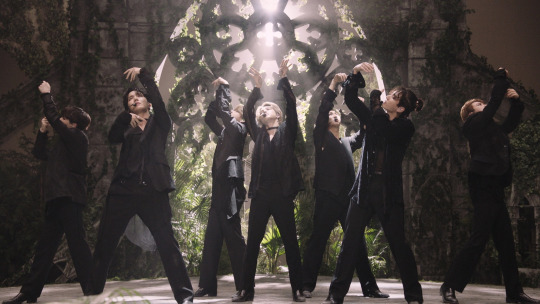
Slowly, I open my eyes
This is my workroom, my studio
Even if harsh waves brush against me in the darkness,
I will never get dragged away again
Inside, I saw myself
In my ears are only fast heartbeats, bump bump bump
With my eyes open, into my forest, jump jump jump
Nothing can swallow me
I cry out with all my strength
The resistance they put forward is, again, painted so vividly that the switch in mindset is felt through their vocals alone. Emptiness can be tempting, ironically, and easy to get lost in. The possible loss of the meaning they embedded into making music and performing, can be stealthily tiptoeing around them at all times. It can wait all it wants, but as long as BTS has a studio to seek comfort in, they’ll continue into the tunnel. The silent cries gain ferocity with every beat they produce, every lyric they scribble.
As they dig even deeper to their concealed shadows, BTS discovers that even their fears carry elements of their own self, ultimately showing their true reflection. It’s within this reflection that they are reminded of why they embarked on this rough journey in the first place.
youtube
Black Swan’s music videos, there are two, contribute immensely in the song’s overall message. The initially released orchestral version was performed by a Slovenian dance group, MN Dance Company. The video is shot in what seems to be an abandoned shopping mall. There are seven dancers, and a story is told through their dancing alone. One of the dancers tries to battle his way out of the pressure and darkness that follows him in the shape of six other dancers. What starts with the six overpowering, ends with the one gaining back his control. He uses what beat him to the ground, to take the shape of the wings that will take him up to the sky. Coinciding perfectly with the track’s lyrics, we essentially watch an individual claw his way out of despair.
youtube
The next music video, released with the original version, contains the actual BTS members dancing. Filmed in the dimly lit and vacant Los Angeles Theatre, with the most appropriate grand interior, BTS members are seen encircled with numerous mirrors, lost between empty seats, and with their shadows projected to the theatre walls, looking much bigger than they are and moving on their own.
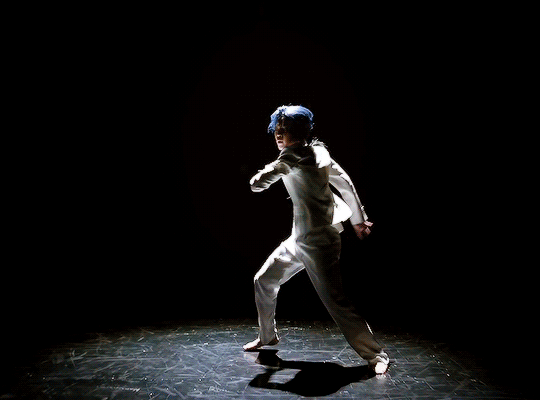
One specific member shines the most with his beautifully mesmerizing solo dance. As the song progresses, we see Jimin bringing death to life through his swift and graceful dancing. Fighting with the shadows, fears, insecurities, bleakness, Jimin at last gives in and dies his first death. The pain he is to be feeling is expressed with every enchanting movement. The entire video has lights shining on the members from the back, stretching out the sizes of their shadows on the grounds they dance on. At the very ending, we also see the shadow of Jungkook slowly fading, shrinking.
The fact that this whole video is just them performing in an empty theatre, makes the impact left by the end much more stronger. They are still performing, even when the lack of audience is making the darkness surrounding the stage stand out more. It’d be near impossible to understand precisely what it is that circulates their minds and drives them into painful positions, however, their heartfelt words and raw expressions provide an entrance ticket.
Black Swan can easily be one of the most personal songs BTS has released in their seven year career, in my opinion. It requires a certain level of mastery of words to describe something so personal in a way any listener can find a way to draw relations with their own lives, own worries, own dreams and pits of darkness. Yet, BTS does it. They do it all the time. First, they describe how well they understand. The circumstances may be different, but our feelings take shelter in close proximity. Afterwards, they always shine light on the exit door you think you’d lost sight of. They become the branch of support of so many, solely by hanging on to their own branches tightly.

This can easily reach hundreds of pages, and it still would not be enough. The entirety of the album Map of the Soul: 7, continues BTS’ takes on Jungian psychology by discovering their personas, shadows and egos. This musical rollercoaster of an album is a gem put into the heart of the music industry and Black Swan is only one of its twenty songs to prove it.
For anyone who wants to witness art in its purest form: black swan performance one, two, three. You are most definitely welcome.
4 notes
·
View notes
Text
Time to Stop Associating “Eureka” with Archimedes and Focus on Shinji Aoyama’s 2000 Masterpiece

A travel in search of clarity and purification. Understanding and letting go.
A longing to reach the state of eureka.
Three surviving victims of a bus-hijacking in the remote areas of Kyushu island try to cope with their traumas, both individually and collectively. The healing threesome, along with an outsider to the incident, form a unity and decide to take a road trip to places an unknown serial killer is also visiting.
Whenever I mentally prepare myself to sit through an approximately four hour long film, I usually tend to lean towards ones that will make up for my by then weary mind with their solid conversations, striking colors and captivating plot events. So, naturally, when I stumbled upon Shinji Aoyama’s 2000 drama Eureka, a sepia film with a 3 hour 38 minute mark and not the most action-based structure, I flinched, hesitated, procrastinated and after several weeks, I finally sat down to watch it. I knew it could go either two ways: I could be bored out of my soul in the first half and shamelessly give up midway or I could feel the immense gratification of having enough of an attention span to help witness a masterpiece. I had given more possibility to the initial option rather than the latter, just to eventually be wronged. Eureka and I were the components of an intimidation-to-love trope because, without a doubt, it has become one of my all-time favorite films with solely the first watch.
I guess it would be fair to mention not everyone will appreciate it the same way, or even find enough patience to sit through the whole thing but I can wholeheartedly say, it is absolutely worth the time.

For a visual sequence where a particular trauma is in focus, it is fascinating how one feels so drawn in to the storyline without completely witnessing the actual event. Aftermath of gunshots, terrified looks on hostages’ faces, scattered dead bodies and a mad man are what we see; sexual assault and beating are what’s implied; and the exhaustive journey of dealing with survivor’s guilt, loneliness and the desperation derived from not being able to express yourself are what we are dragged in to experience.
Every little detail is presented in subtle harmony, quite contrary to what lies in the film’s essence. The severity of what each character is buried under is in an opposition with the monochromatic tones that paint each wide scenery even more peaceful than they already are.

Eureka serves the role of an epiphany. The epiphany of realizing what you went through can be a part of you, but it does not have to define you. It does not have to play a role in the molding of the rest of your life. There are no set standards for what a survivor ought to fit into. It is a reminder that there is no one fixed method in mental survival and that surviving is not a crime.
Such heavy and sensitive topics couldn’t have been easy to portray within a film so quiet, so calming. The excruciating struggle of not being understood by friends and family is twisted around to assure that at least the viewer gets it. With every passing minute, you are faced with the reality of acceptance. How deceiving it is underneath all the agony. How it lurks in the fragments of that incident, waiting to find a chance to mislead you. Is the clarity you are craving in vengeance? In surrendering to evil? In art and nature? Or in a road trip? The answer to these questions are sneaky, and the painful confusion of sensitive minds are easy targets. The rest of the equation is self-explanatory.

I am forever glad I sat down on a Sunday evening to watch Eureka. By the end of it, it also becomes obvious that the duration is also an important factor in communicating the film’s message. Acceptance is time consuming, sometimes even annoying. Everything falls into line perfectly. Particular scenes and quotes still linger in my mind, increasing my admiration as time goes by. Its sepia covered features are all worthy of remembrance.
To cut a post that could easily turn into a full length essay short, if you ever want to feel atmospheric heartbreak and have nearly four hours to spare, I recommend you watch the masterfully crafted beauty that is Eureka. I really hope you cherish it as much as I do.
15 notes
·
View notes
Text
It’s 1999 and Fatboy Slim is Praising You

Following are my humble opinions and interpretations on a 90s gem, as a 00s professional observer. Enjoy!
For starters, I find it fairly interesting how Spike Jonze’s mind works with seeing beyond the line of norms in music video making as well as films. His 1999 film Being John Malkovich was followed by me staring at the screen and thinking “Wow, how does one even come up with that?” and I don’t think I’m alone on this. It’s a cinematic ride that flows along really easily and gets more intriguing by the minute, showing me the degree of Spike Jonze’s capability in delivering out-of-the-box and quite marginal ideas. So, evidently, it comes as no surprise to me that that he was also the one to detect a boy listening to Praise You (1999) on the streets -with what I assume are impromptu dance moves- and see it as a much more refreshening visual than an extravagant and luxurious music video could provide. Using imagination in taking that extra step seems like what he is accustomed to, from an outsider perspective. When I was watching Norman Quentin Cook’s, Fatboy Slim, interviews on Praise You music video, it was pleasuring to hear him talk about how quickly he was on board with Jonze’s idea after watching the VHS recording of the random boy, and was persistent in its execution despite other authorized figure’s understandable hesitance. It is leaps like these that set the basis for new and glossy grounds, waiting to become the next glorified trend.

In 2021, music videos of flash mobs and quirky dancing people may not be the most extraordinary concept but in 1999, it apparently was. The unsynchronized style of elderly amateurs, puzzled and a little disturbed glances of non-staged bystanders, exaggerated gestures and a compact venue of a theatre’s entrance instead of an open and wide sidewalk; they are all impactful components in making the music video that much closer to the viewer. Who does not dance in their room, the kitchen when no one’s looking, the narrow hallways of their house? And who does not just let loose and do silly, embarrassing, free moves once in a while, just for the sake of it — even if you are a true and utter professional? The music video, to me, is highly resemblant to those moments where the music is all about having fun and recharging your body, your mind. The fake dance team in Praise You moves in accordance to the rhythm and lyrics of the song but there really is no unity. However, this does not stop it from being a satisfactory experience for the viewer -well, maybe not the ones who were physically there as they seemed to be confused out of their minds, but for an audience of the future, I believe it’s definitely worthy of looping-.

The fact that this video is so immensely well-known and is considered to be one of the best becomes a self-explanatory statement once you, (1) watch it, (2) read about it and (3) watch it again. It’s fun, energetic, amusing, a new perspective, easy to mentally place yourself in the scene and a pure example of grand investments not being the only path to follow in the portrayal of a groovy good time.
8 notes
·
View notes